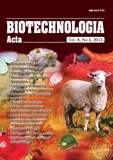ISSN 2410-776X (Online),
ISSN 2410-7751 (Print)

Biotechnologia Acta" V. 8, No 3, 2015
https://doi.org/10.15407/biotech8.03.123
Р. 123-128, Bibliography 13, English
Universal Decimal Classification: 579.266
REGULARITIES OF QUANTITATIVE DISTRIBUTION FOR FE(III)-REDUCING BACTERIA IN NATURAL ECOSYSTEMS
Govorukha V. M.1, Havrylyuk O. A.2, Tashyrev O. B.1
1Zabolotny Institute of Microbiology and Virology of the National Academy of Sciences of Ukraine, Kyiv
2National Aviation University, Kyiv, Ukraine
The aim of the work was quantitative determination of Fe(III)-reducing bacteria in natural ecosystems of the Antarctic, the Arctic, the Dead and the Black Sea, middle latitude (Ukraine, Abkhazia) and the equatorial zone (Ecuador).
It was used the method of quantitative determination of microorganisms by McCready and the colorimetric method for determination of Fe(II) compounds .
Results. The systemic study of the number of Fe(III)-reducing bacteria of both hemispheres in the ecosystems of six geographic regions was carried out for the first time. High number of Fe(III)-reducing bacteria in natural ecosystems was experimentally shown. The number of Fe(III)-reducing bacteria ranged from 1.1•102 to 2.8•107 cells/g of absolutely dry sample.
Conclusions. The presented data showed that Fe(III)-reducing bacteria are an integral part of natural ecosystems and can significantly affect the biogeochemical cycles of iron and carbon compounds transformation.
Key words: quantity of Fe(III)-reducing bacteria, natural ecosystems, biogeochemical cycles of iron.
© Palladin Institute of Biochemistry of the National Academy of Sciences of Ukraine, 2015
References
1. Slobodkin A. I. Thermophilic iron-reducing prokaryotes. Dissertation, INMI RAN. Мoskva, Russia, 2008. (In Russian).
2. Lovley D. R. Organic matter mineralization with the reduction of ferric iron: a review. Geomicrobiol. J. 1987, 5(3/4), 375–399.
3. Aristovskaya T. V. Microbiology of the processes of soil formation. Leningrad: Nauka. 1980, 187 p. (In Russian).
4. Becker M., Asch F. Iron toxity in rice-conditions and management concepts. J. Plant Nutr. Soil Sci. 2005, V. 168, P. 558–573.
http://dx.doi.org/10.1002/jpln.200520504
5. Nealson K. H., Myers Ch. R. Microbial reduction of manganese and iron: new approaches to carbon cycling. Applied and Environmental Microbiology. 1992, 58(2), 439–443.
6. Lovley D. R. Dissimilatory metal reduction. Annu. Rev. Microbiol. 1993, 47, 263–290.
http://dx.doi.org/10.1146/annurev.mi.47.100193.001403
7. Shekhovtsova N. V., Verkhovtseva N. V. Ironreducing microorganisms in ultra-deep volcanic rocks. Vestnik OGU. 2011, 12(131), 363–365. (In Russian).
8. Kostka J. E., Wu J., Nealson K. H., Stucki J. W. The impact of structural Fe(III) reduction by bacteria on the surface chemistry of smectite clay minerals. Geochimica et Cosmochimica Acta. 1999, 63(22), 3705—3713.
http://dx.doi.org/10.1016/S0016-7037(99)00199-4
9. Weiss J. V., Emerson D., Backer S. M., Megonigal J. P. Enumeration of Fe(II)-oxidizing and Fe(III)-reducing bacteria in the root zone of wetland plants: Implications for a rhizosphere iron cycle. Biogeochemistry. 2003, V. 64, P. 77–96.
http://dx.doi.org/10.1023/A:1024953027726
10. Sendel Е. Colorimetric methods of trace metals determination. Мosk va: Мir. 1964, 899 p. (In Russian).
11. Kamenskaya E. P., Averyanova E. V. Quantitative determination of micro organisms: guidelines for laboratory work. Biysk: Izd-vо Alt.gosс. tekh. un-ta. 2007, 35 p. (In Russian).
12. Tepper E. Z., Shilnikova V. K., Pereverze ua G. I. Workshop for microbiology. Мoskva: Agropromizdat. 1987, 239 p. (In Russian).
13. Shlegel G. General microbiology. Мoskva: Мir. 1987, 567 p. (In Russian).

